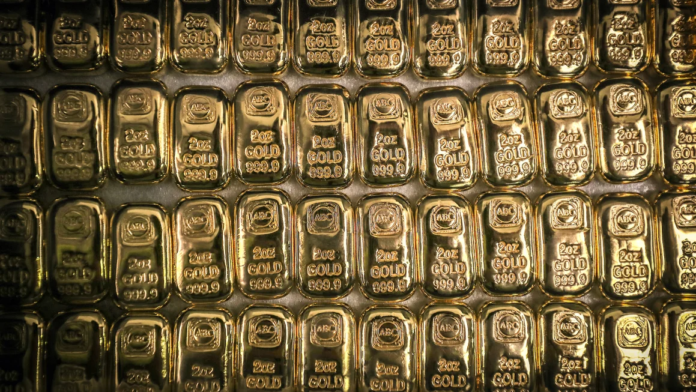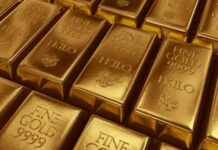
From central banks to Costco customers, it seems everyone is buying gold these days.
The price of spot gold reached $2,364 per ounce Tuesday, after hitting record highs for seven straight sessions and trading at $2,336 per ounce Monday. Year-on-year, gold is up 16.5%.
Investors who expect the Federal Reserve to cut its benchmark interest rate are the main force driving up prices, but the surge is boosted by other factors, including central banks — led by China — buying up gold to ease reliance on US dollars.
Central banks see gold as a long-term store of value and a safe haven during times of economic and international turmoil.
Gold is considered a resilient investment. When interest rates fall, gold prices tend to rise, as bullion becomes more appealing than income-paying assets like bonds. Investors also regard gold as a hedge against inflation, betting bullion will retain its value when prices rise.
The People’s Bank of China bought gold for the 17th straight month in March, adding 160,000 ounces to bring reserves to 72.74 million troy ounces of gold, according to Reuters.
Central banks may want to “diversify away” from US dollars and buy gold amid geopolitical uncertainty, according to an April 9 UBS research note. As China builds its reserves, demand is pushing up prices, already boosted by usual investors.
Chinese investors are looking to gold as an alternative asset amid downturns in property valuations and equity prices in past years, according to an April 9 Capital Economics research note.
Other central banks, including India and Turkey, are also increasing their gold reserves. India’s GDP growth is driving those purchases, according to UBS.
A sign of the times?
Central banks demanding gold is a sign of waning reliance on the dollar, according to Ulf Lindahl, CEO at Currency Research Associates.
Dollars are increasingly unappealing for central banks who want to decrease economic reliance on the US, Lindahl said in an email.
Nations not allied with the US may accumulate gold to “mix away from dollars” to reduce vulnerability to sanctions, according to a March JP Morgan research note.
Central bank buying has driven the rise in gold prices since 2022, according to the note. Gold could be entering a strong era, as central bank purchases of gold in 2022 were more than double the average annual purchase across the decade prior, according to JP Morgan.
The rise in prices comes amid US Treasury Secretary Janet Yellen’s visit to China to discuss financial stability in US-China relations, including what Yellen called the overproduction of Chinese electric vehicles.
Oil prices are also on the rise, posing a threat to the US economy, according to Mark Zandi, chief economist at Moody’s.
Higher oil prices are likely to stoke concerns over inflation, boosting gold prices, according to the UBS research note.
The usual perception of gold
The rise in gold prices signals investors are anticipating rate cuts from the Fed later this year but might be uncertain about the prospects of squashing inflation without throwing the US economy into recession, also known as a soft landing.
UBS sees the expectation of Fed rate cuts as “still the main driver for bullish sentiment toward gold,” according to an April 9 research note.
Fed Chair Jerome Powell said in remarks April 3 that inflation is still on a “sometimes bumpy path” toward the Fed’s goal of 2%, and that rate cuts to rebalance the economy are likely to begin at some point later this year.
Fifty-one percent of investors currently expect a quarter-point cut in June, according to data from CME group. Yet job growth data for March exceeded expectations, calling into question the need for multiple rate cuts amid a still-strong economy.
The Personal Consumption Expenditures price index, the Fed’s preferred inflation gauge, rose 2.5% for the 12 months ending in February. That’s a tick up from January’s 2.4% increase, according to Department of Commerce data released last month.
On a monthly basis, the core PCE price index that strips out the more volatile food and energy categories, rose 0.3%. The index, which Fed officials view as a crucial gauge of underlying inflation, was down from 0.4% in January, when it had grown at the fastest pace in one year.
So why is gold surging right now?
Some investors are buying into the hype around gold bullion as prices rise, pushing them further up. On Reddit, proud gold buyers often post threads about their stashes.
Costco began selling gold bars online in August and silver coins in January. The company may now be selling as much as $200 million in gold and silver each month, according to an estimate by Wells Fargo. Chief Financial Officer Richard Galanti told analysts in December that the company had sold more than $100 million of gold bars in the prior quarter.
“The accelerating frequency of Reddit posts, quick on-line sell-outs of product, and [the company’s] robust monthly eComm sales suggests a sharp uptick in momentum since the launch,” the April 9 investment note said.
Lindahl said that “trend followers” and others jump on the rise in prices as the background begins to point to substantially higher prices over the long term.
It’s also worth noting that gold is a traditional asset to hold during political uncertainty. Voters in more than 60 countries are set to head to the polls this year, including for the US presidential election. That uptick in geopolitical and economic unpredictability underscores the precious metal’s stable value.






